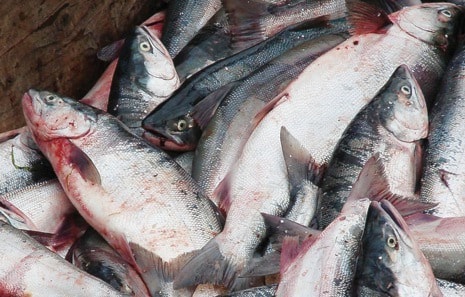While Fisheries and Oceans Canada is calling the aboriginal food fishery “out of control” with most of the Fraser River salmon sold on the black market, it’s a different story at the Katzie First Nation in Pitt Meadows.
“I can only speak to Katzie on this. When we’re out there food fishing, we’re actually food fishing,” Katzie Chief Jay Bailey said Thursday.
That means the fish caught for food or ceremonial purposes is either frozen, canned or smoked for use on the reserve.
“I don’t sell fish under the table like that. I’m sure that most of the members are on the same wavelength. We really don’t depend on fishing anymore for income.
“We can’t sell it. If we’re out there for food or ceremonial, we can’t sell it. It’s illegal.”
The 2006 Fisheries assessment was tabled as evidence recently at the Cohen Commission into the decline of Fraser sockeye.
Bailey added that if fishing conditions are good, then Fisheries and Oceans Canada and the Katzie will make an agreement to allow the band to sell some of that catch, providing the numbers warrant that. If that’s the case, Bailey says he’ll fish as much as he can.
That was the case last summer. “All of a sudden, we’re flooded with fish and they let us sell the fish.”
But in most recent years, food fisheries only took place within limited time periods. Under those conditions, Bailey only takes what he needs for personal or family purposes. Allocations for the food and ceremonial fishery changes every year.
He adds that most of the band has someone in the family who fishes who can supply family members.
“It’s not the main income anymore for families. They have had to look for other things to do. We’re a little lucky here because were kind of urbanized when it comes to employment.”
Fisheries and Oceans Canada also hires monitors to check the boats as they come in with fish, he pointed out. He estimates there are between 20 and 30 boats on the reserve.
“So they keep a pretty strict eye on us, which I understand.”
He wonders how the Fisheries department came up with the figure that 97 per cent of the Fraser salmon fishery goes to the black market.
“I guess all I can assure you is Katzie’s not like that. Can’t speak for other nations.”
Sports fishing columnist Jeff Weltz also challenges the figure.
Most aboriginal fishermen he knows follow the rules and hasn’t heard of band members going without fish.
“I’m not really interested in getting behind the DFO and backing them on anything because they’re pro fish farms and this (along with urban development near streams) is probably the biggest threat to fisheries more than anything.
“DFO refuses to recognize this.”
He pointed out that the large runs of pink and sockeye salmon coincided with previous periods when fish farms up the coast were required to go fallow, meaning wild stocks got a break from the sea lice. He’s caught fish with sea lice in the Stave River.
Mission resident Bob McKamey, with the B.C. Fisheries Survival Coalition, hopes the Cohen Commission of Inquiry into the Decline of the Sockeye Salmon in the Fraser River will see improvements into the way the salmon fishery is managed.
He said the fact that the revelation came from Fisheries in 2005 raises the question – why the department didn’t change its practices after that.
“I don’t think they can defend or manage that in the same way as before.”
Hopefully the commission will come up with a better way of managing the fisheries. “This clearly isn’t the way to run it.”
McKamey added that he supports a food fishery, providing it’s for those purposes, and says the million fish now allocated for those is way above the 250,000 previously allotted for aboriginal food-ceremonial fishing.
But Bailey says you could make the same argument for cutting the sports fishery.
He’d like to see the Fraser River and the ocean salmon fishery managed as one.
“It really doesn’t seem fair to me that other people get to fish outside the Fraser when we’re stuck here not fishing.”
He also says the shrimp fishery should be put on hold, while the endangered eulachon are spawning because many are scooped up as bycatch by shrimp trawlers.
“It doesn’t make sense to me while they’re allowed to catch eulachon when we’re allocated 50 pounds to feed an entire community … and they’re catching tonnes and tonnes of these things in a day.”
The Fraser River eulachon, a small, fat-rich fish prized by First Nations, have been designated an endangered species by the Committee on the Status of Endangered Wildlife in Canada, after a 98-per-cent decline in its numbers, the past decade.
Eulachon, also spelled oolichan, is dubbed saviour fish by some aboriginals who counted on it to bridge over gaps in the salmon catch, and candlefish by others because they’re so oily they can be dried and burned like candles.
He also hoped that the Cohen Commission could improve fish management on the Fraser River. “I think the stocks need any help they can get, otherwise my grandsons and granddaughters won’t be able to fish.”
